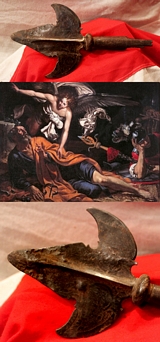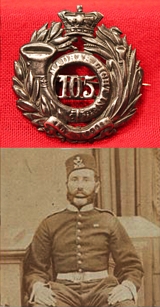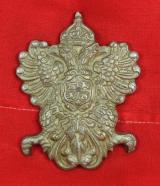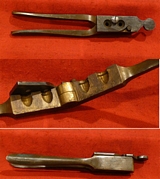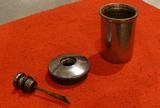Antique Arms & Militaria
A Rare 1853 Royal Warwickshire Regt. Historically Significant ‘Jamaican Rebellion’ Enfield Bayonet The Morant Bay Rebellion, From a Defender of Paul Bogle.
Regimentally marked bayonet for the 6th Regiment, the Royal Warwickshire. Maker marked by Deakin and full ordnance inspection stamps. A souvenir from a descendant of a defender of Paul Bogle’s, used with its service issue 1853 Enfield pattern rifle, in the Jamaican Rebellion in Morant Bay of 1864/5. The 1865 Jamaican uprising was put down by 6th Regt, The Royal Warwickshire soldiers. A leader of the Warwickshire Regiment, Colonel J. Francis Hobbs, led the British reprisals against Bogle’s community. Hobbs report to Governor Eyre (19 October) resulted in a commendation for bravery: "I found it most dangerous work crossing over the numerous rivers, which took the men above their waists. There was not a single non-commissioned officer or soldier who was not literally wet through, and every article of their clothing, saddlery, etc., utterly destroyed.
"Added to this, the entire darkness of the night made it a march never to be forgotten in the 6th Regiment. About daylight this morning, in passing through this village of cross roads, where the rebels destroyed everything, I found a number of special constables, who had captured a number of prisoners from the rebel camp. Finding their guilt clear, and being unable to take or leave them, I had them all shot. The constables then hung them up on trees, eleven in number. Their countenances were all very diabolical, and they never flinched the very slightest.
"From this we at once went to Stony Gut After partaking of some biscuits and rum in Bogle’s chapel, sending off his lamps as a trophy to his excellency the governor, and utterly destroying this rebellious settlement, I have returned with my jaded and sore-foot troops to this spot, where we bivouacked for the night in another ecclesiastical building, called the Chigoe-Foot Methodist Chapel.
"I must not forget to tell you that I have got Paul Bogle’s valet for my guide, a little fellow of extraordinary intelligence. A light rope tied to the stirrup, and a revolver now and then to his head cause us to understand each other; and he knows every single rebel in the island by name and face, and has been selecting the captains, colonels and secretaries out of an immense gang of prisoners just come in here, whom I shall have to shoot to-morrow morning."
Hobbs account of this bloody expedition was used as evidence in the Royal Commission of Inquiry which was set up to investigate Eyre’s role. Although it is doubtful whether Hobbs would have received the missive in time, he was certainly acting in the spirit of his commander’s instructions; the Deputy Adjutant-General John Henry Elkington (from a family of military officers with branches in Warwickshire and Leicestershire), had written to him on 18th October: "Colonel, I send you an order to push on at once to Stony Gut but I trust you are there already. Hole is doing splendid service with his men all about Machioneal" Paul Bogle (1822 to 24 October 1865) was a Jamaican Baptist deacon and activist. He is a National Hero of Jamaica. He was a leader of the 1865 Morant Bay protesters, who marched for justice and fair treatment for all the people in Jamaica. After leading the Morant Bay rebellion, Bogle was captured by government troops, tried and convicted by British authorities under martial law, and hanged on 24 October 1865 in the morant bay court house. The "Eyre Controversy" turned into a long and increasingly public issue, dividing well-known figures of the day. It may have contributed to the fall of the government. In 1866 John Stuart Mill set up and chaired the Jamaica Committee to examine the atrocities committed in Jamaica in the course of ending the rebellion. Thomas Carlyle set up a rival committee to defend Eyre. His supporters included John Ruskin, Charles Kingsley, Charles Dickens and Alfred, Lord Tennyson. read more
425.00 GBP
A Superb Victorian Hampshire Regt. Officers Full Dress Belt and Belt Plate One of the Best Examples We Have Ever Seen
A most scarce pattern of Victorian Hampshire regimental waist belt In 24 carat gilt and gold bullion, over red Morocco leather. Very few of these beautiful quality belts survive complete, and this is a truly exceptional one. Manufactured by Potter of London. Known as the Hampshire Tigers, the buckle bears the symbols of the Indian Tiger, and the Rose plucked from the Battle of Minden. The Hampshire Regiment was formed on 1st July 1881 when The 37th (North Hampshire) Regiment of Foot and The 67th (South Hampshire) Regiment of Foot were merged as part of the Childers reforms. Portrait miniature of an officer of the 37th or North Hampshire Regiment of Foot in the gallery for reference not included
The 37th Regiment of Foot was first formed in 1702 and as was the tradition at the time named ?Meredith?s Regiment? after Thomas Meredith, the Colonel of the Regiment who raised it in Dublin. The Regiment then served in various campaigns including The War of Spanish Succession (1704-1710) and The War of the Austrian Succession (1740?1748). In 1745 The Regiment returned to England when Bonnie Prince Charlie (the grandson of the deposed James II) landed in Scotland, attempting to regain the crown lost to the Stuart family in 1688 and incited the Jacobite Rising. The Regiment fought for the Hanoverian King George II at the Battles of Falkirk and Culloden. In 1751 the Regiment became The 37th Regiment of Foot as part of a scheme to simplify the naming system of British Army Regiments. The Regiment was once again involved in foreign campaigns including, The Seven Years War (1756?1763) and The American War of Independence (1775-1783). In 1783 The 37th became The 37th North Hampshire Regiment in order to aid recruitment. The Regiment was involved in various campaigns including The Peninsular War and The First War of Indian Independence.
The 67th Regiment of Foot was initially the 2nd Battalion of the 20th Foot but detached in 1758 and became the 67th of Foot. The Regiment saw its first action on the aborted expedition to capture St. Malo in 1758. It was part of the force sent to capture Belle Isle during the Seven Years War, also served in The Spanish invasion of Portugal 1762 and was stationed in India from 1805 after the Second Anglo-Maratha War and participated in The Third Anglo-Maratha War (1817?1818), remaining in India for 21 years. In 1783 The 67th became The 67th South Hampshire Regiment in order to aid recruitment. The Regiment was further involved in foreign campaigns including The Second and Third China Wars (1857-1865) and The Japan Expedition (1862?1864).The 67th return to England after 21 years and authorisation to carry the Royal Bengal Tiger on the Regimental Colours
In February 1826, after spells in Sholapore and Poona, the regiment was sent to Rangoon to reinforce British troops engaged in the Burmese war.
Both Regiments were amalgamated in 1881 as part of the Childers Reforms and became the Hampshire Regiment. The Childers Reforms restructured the British army infantry Regiments. The newly formed Regiment engaged in various foreign campaigns including; Secunderabad (1886-1888), Burma (1888?1891), South African War (1899?1902), and two World Wars. read more
645.00 GBP
Welcome to The Lanes Armoury, The Magical Place Where Wonders Are For Sale
Our beautiful pieces from history are not always just for looking at, some can still be enjoyed and worn for every one to see.
We Are Not Just A Webstore, We Are Always Welcoming Personal Visitors To Our Gallery In Brighton Every Day*
Thousands of original pieces of history, for example, from Ancient Rome and Greece to Medieval Japan, and Viking Europe. Covering British, European, and in fact, all worldwide eras of historical events from the past 4000 years, with antiquities, weaponry, armour, object d’art, militaria and books from the bronze age to WW2.
Personalised Certificates of Authenticity supplied with every purchase.
Our family have been personally serving the public in Brighton for generations, in fact, for over 100 years.
* Opening hours Monday to Saturday 11.00am till 4.00pm read more
Price
on
Request
A Battle Worn Original Early 17th Century Italian Partizan Polearm Head
Steel three prong partizan decorated with birds on a floral background from the 1620's. Battle damaged and a fabulous artifact of 17th century warfare. With later haft [not shown] A partizan (also partisan) is a type of polearm that was used in Europe in the Middle Ages. It consisted of a spearhead mounted on a long shaft, usually wooden, with protrusions on the sides which aided in parrying sword thrusts. From the era of the Italian Wars of Castro. They were a series of conflicts during the mid-17th century revolving around the ancient city of Castro (located in present-day Lazio, Italy), which eventually resulted in the city's destruction on 2 September 1649. The conflict was a result of a power struggle between the papacy ? represented by members of two deeply entrenched Roman families and their popes, the Barberini and Pope Urban VIII and the Pamphili and Pope Innocent X ? and the Farnese dukes of Parma, who controlled Castro and its surrounding territories as the Duchy of Castro. We do have its polearm 70 inches long overall, 12.5 head incl. side straps read more
675.00 GBP
A Most Rare Victorian, Anglo Indian, British Raj, Silver 105th (Madras Light Infantry) Officer Glengarry Badge
From the British Raj, one of the most desirable eras of collectable militaria of Anglo Indian history. Pre 1881 Silver coiled bugle horn couched within crowned sprays of laurel and palm, the horn with central floreate numerals 105, on the curl of the horn Madras Light Infty.. A scroll on the junction of the leaf sprays Cede Nullis. Sealed in 1876. Became the King's Own Yorkshire Light Infantry in 1881 The 105th Regiment of Foot (Madras Light Infantry) was an infantry regiment of the British Army from 1862 to 1881, when it was amalgamated into The King's Own Light Infantry (South Yorkshire Regiment).
The regiment was originally raised by the Honourable East India Company in 1839 as the 2nd Madras (European) Regiment, redesignated the 2nd Madras (European) Light Infantry in 1842, and served in the Indian Mutiny of 1857. As with all other "European" units of the Company, they were placed under the command of the Crown in 1858, and formally moved into the British Army in 1862, ranked as the 105th Foot.
As part of the Childers Reforms in 1881, the regiment was amalgamated with the 51st (the 2nd Yorkshire West Riding) or King's Own Light Infantry Regiment to form The King's Own Light Infantry (South Yorkshire Regiment). read more
295.00 GBP
A Large 19th century European, Imperial, Crowned, Twin Headed Royal Eagle Crest Mount
In hard metal, probably solid nickel. A most attractive piece that could beautifully embellish either a fine box, door, cabinet, case, or maybe a bespoke wooden plaque. 225 grams, 3.5 inches x 4.5 inches read more
225.00 GBP
An Exception Adams Pattern Antique 120 Bore Double Bullet Mould
A singularly fine piece in stunning original patina and it's original bluing to the steel sprue-cutter. This would be absolutely perfect for a cased 120 bore Adams revolver lacking it's mould. Also superb piece for collectors of fine English antique revolver accessories. You simply couldn't find a better example. read more
395.00 GBP
A Good Original Antique Nickel G &JW Hawksley Gun Case Oil Bottle
19th century Ideal for all kinds of cased pistols or long guns. Excellent condition. 3cm across [at widest] 5.5cm inches high read more
105.00 GBP
A Beautiful Antique African Tribal Art Carved Paddle-Spear Possiblt From The Itsekiri PeopleOr Even Benin
In carved native wood with geometric carving and piercing. This is a dance paddle of the kind used in ceremonies by the Itsekiri people of the Niger delta. The river was at the centre of tribal society and economy – it provided food and transport for the communities who lived in the area. Canoes were an extremely important part of traditional society and so the paddle was an important symbol for prosperity. Local people relied on the river for their quality of life and believed in water spirits. This paddle is decorated with intricate carving and may have been used in ceremonial dances. Alternatively, it may have been made for trading with Europeans as ethnic objects became fashionable possessions. Although African, like Oceanic art it is often infused with ancestral spirits, as well as spirits of water, air and land. These spirits are contacted in ceremonies to ensure fertility, or invoke protection from famine, disease or enemies.
Sometimes these invocations serve extremely practical purposes. There was a ceremony in Papua New Guinea where ancestral spirits were activated in a carved wooden crocodile. Men carrying the crocodile were then led, like people holding a divining rod are led, to the home of a local murderer.
African and Oceanic art is not only made for decoration. It is made to be used as a tool in the culture. In the 20th century, Cubist painters, and especially Surrealists, were moved by the power of Oceanic abstractions, as they were by traditional African art. This wonderful piece would make a stunning additional display of object d’art in any setting, albeit traditional or contemporary read more
475.00 GBP
A Super, Antique Bronze Equestrian ' Horse Racing' Collectable
Ideal for the gentleman or lady with a passion for horse racing, horses or equine collectibles. In fine cast bronze, in the form of chamber stick. With a finely detailed relief design of a horse race, showing two race horses side by side with jockeys. With a mount for a matchbox, and a rear finger loop for holding and carrying. read more
275.00 GBP





